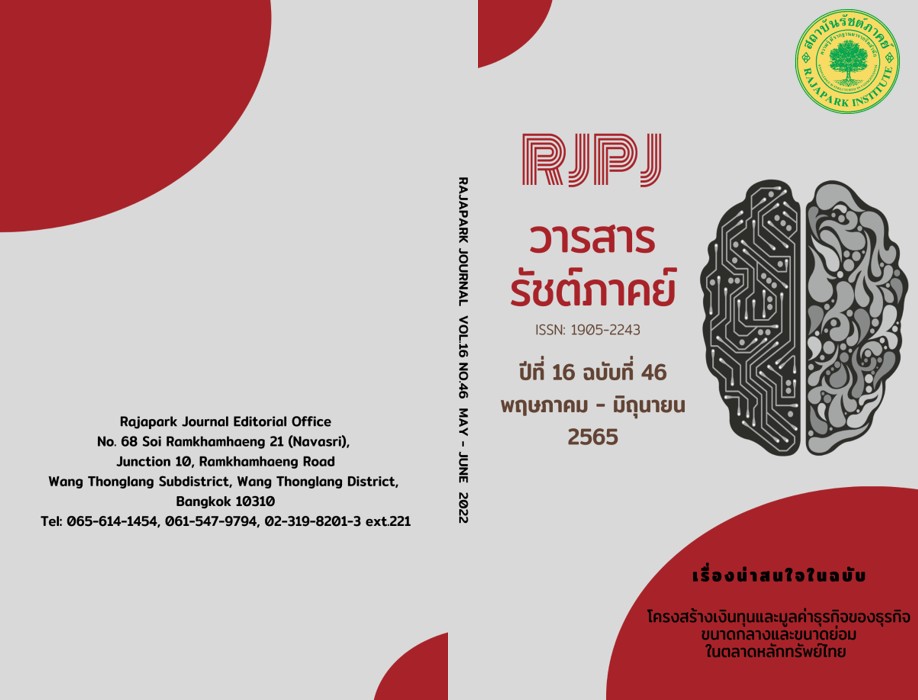The Role of the Administrator in the Hidden Curriculum of Induction and Its Influence on the Retention of Newly-hired Teachers in International Schools in Thailand
Main Article Content
Abstract
The aims of this research are as follows: 1) to study the role of administrators in the hidden curriculum of induction, and 2) to examine how the role of administrators in the HCI affected the retention of newly-hired teachers in international schools in Thailand. The study used an integrated qualitative and quantitative approach which was divided into two phases. In phase one, 15 key informants from seven IB schools through in-depth interviews. In phase two, the sampling group for the quantitative approach consisted of 127 newly-hired teachers. The data were analyzed using percentage, mean, standard deviation, Pearson’s Correlation Coefficient, Multiple Regression Analysis, and Simple Regression Analysis. The results were as follows: 1) the role of the administrator in the HCI was the selection of mentors, administering and developing a clear and explicit induction program, creating school contexts, evaluating induction, creating a working atmosphere and being a role model, and balancing the work and personal lives of newly-hired teachers 2) the relationship between the role of administrators in the HCI and the retention was positive at the medium level and was correlated with a statistical significance of .05; and 3) the highest predictive power was an explicit induction program, followed by the creation of school contexts and creating a working atmosphere and being a role model. 4) the role of administrators in the HCI could predict retention with a statistical significance of .50.
Article Details

This work is licensed under a Creative Commons Attribution-NonCommercial-NoDerivatives 4.0 International License.
Views and opinions appearing in the Journal it is the responsibility of the author of the article, and does not constitute the view and responsibility of the editorial team.
References
Barrett, S.E., Solomon, R.P., Singer, J., Portelli, J.P., & Mujuwamariya, D. (2009). The Hidden Curriculum of a Teacher Induction Program: Ontario Teacher Educators' Perspectives. Canadian Journal of Education, 32(4), 677-702.
Billingsley, B., Carlson, E., & Klein, S. (2004). The Working Conditions and Induction Support of Early Career Special Educators. Exceptional Children, 70(3), 333-347. https://doi.org/10.1177/001440290407000305
Brucknerova, K., & Novotný, P. (2017). The Influence of Principals on the Hidden Curriculum of Induction. Educational Management Administration & Leadership, 47(4). 606-623. DOI:10.1177/1741143217745878
Cowin, L. S., & Hengstberger-Sims, C. (2006). New Graduate Nurse Self-concept and Retention: a Longitudinal Survey. The International Journal of Nursing Studies (IJNS), 43(1), 59-70. DOI: 10.1016/j.ijnurstu.2005.03.004
Haiyan, Q., Walker, A., & Xiaowei, Y. (2017). Building and leading a learning culture among teachers: A case study of a Shanghai primary school. Educational Management Administration & Leadership, 45(1), 101-122. https://doi.org/10.1177/1741143215623785
Higgins, F. (2019). International Education Teacher Induction in International Schools. file:///C:/Users/HP/Downloads/DissertationFinal.pdf
International Baccalaureate Organization. (2020). About the IB. https://www.ibo.org/about-the-ib/
International School Consultancy Research [ISC]. (2020). Online International Schools Database. https://www.iscresearch.com/services/isc-online
KIS International School. (2020). KIS International School in Bangkok: Thai. https://www.kis.ac.th/kis-international-school-bangkok-Thai
Krasnoff, B. (2014). Teacher Recruitment, Induction, and Retention. https://compcenternetwork.org/sites/default/files/ archive/research-brief-teacher-recruitment-induction-retention.pdf
Krejcie, R. V., & Morgan, D. W. (1970). Determining Sample Size for Research Activities. Educational and Psychological Measurement, 30(3), 607-610.
Mancuso, S. V., Roberts, L., & White, G. P. (2010). Teacher Retention in International Schools: The Key Role of School Leadership. Journal of Research in International Education, 9(3), 306-323. DOI: 10.1177/1475240910388928
Office of Private Education Commission. (2021). Report of Teaching Appointment and Teaching Dismissal. https://webold.opec.go.th/index.php/category/opec-all/special/
Oke, A.O., Ajagbe, M.A., Ogbari, M.E., & Adeyeye, J.O. (2016). Teacher Retention and Attrition: A Review of the Literature. Mediterranean Journal of Social Sciences, 7(2S1), 371-378. DOI: 10.5901/mjss.2016.v7n2s1p371
Okwir, M. (2010). Factors Affecting Teacher Retention in Government-Aided Secondary Schools in Eastern Uganda[Master of Arts, Makerere University].
Oliver, W. L. (2008). The Influence of Principals on Teacher Retention: An Examination of the Relationship Between Principal Behavior and Teacher Retention[Doctoral dissertation, University of Cincinnati].
Pinto, L., Portelli, J., Rottmann, C., Pashby, K., Barrett, S., & Mujawamariya, D. (2012). Social Justice: The Missing Link in School Administrators’ Perspectives on Teacher Induction. Canadian Journal of Educational Administration and Policy, 129, 1-22. https://files.eric.ed.gov/fulltext/EJ971059.pdf
Price, J. L., & Mueller, C. W. (1981). A Causal Model of Turnover for Nurses. Academy of Management Journal, 24(3), 543-565. https://doi.org/10.2307/255574
Ronfeldt, M., & McQueen, K. (2017). Does New Teacher Induction Really Improve Retention?. Journal of Teacher Education, 68(4), 394-410.
Seyfarth, J. T. (1991). Personnel Management for Effective Schools. Allyn and Bacon.
Smidova, Z. (2019). Educational Outcomes: A Literature Review of Policy Drivers from a Macroeconomic Perspective. https://www.oecd-ilibrary.org/docserver/990801aan.pdf?expires=1641793880&id=id&accname=guest&checksum= 3C0925AEF68FDCE213E8859DA4308764
Snoek, M., Eisenschmidt, E., Forsthuber, B., Holdsworth, P., Michaelidou, A., Dahl Norgaard, J., & Pachler, N. (2010). Developing Coherent and System-wide Induction Programmes for Beginning Teachers: A Handbook for Policymakers. https://www.semanticscholar.org/paper/Developing-coherent-and-system-wide-induction-for-a-Snoeck-Eisenschmidt /d6f7da9da46f34871381b71132abeb1c2fa4fffe
Stirzaker, R. (2004). Staff Induction: Issues Surrounding Induction into International Schools. Journal of Research in International Education, 3(1), 31-49. DOI:10.1177/1475240904041464
Wren, D. J. (1999). School Culture: Exploring the Hidden Curriculum. Adolescence, 34(135), 593-596.


